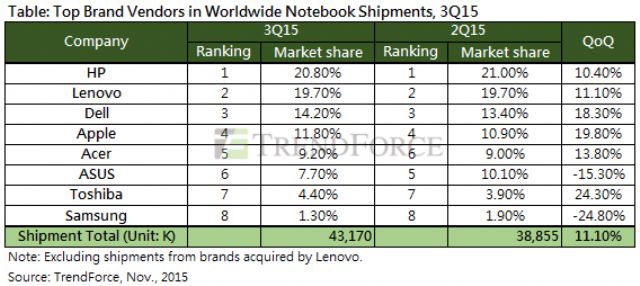Worldwide Notebook PC Shipments Increase 11% QoQ to 43.2 M. Units in Q3: TrendForce
Acer outstrips ASUS as fifth-largest notebook PC vendor thanks to strong shipment growth
2015/11/09 | By Quincy Liang
A market-ranking change in the third quarter was that Taiwanese PC vendor Acer outperformed major local rival ASUS to be the No. 5 during the period, thanks to its 13.8 percent QoQ shipments, compared to a 15.3 percent QoQ drop by ASUS.
After experiencing shipment slump in the first half of 2015, branded notebook vendors have been striving to finish the year off with a strong recovery by making a comeback with all-out effort to raise their shipments. In the third quarter, TrendForce said, notebook PC demand remained strong in the U.S. and started to pick up in China. The stabilization of currency exchange rates has also resulted in a gradual turnaround in the European notebook market.
Anita Wang, TrendForce's analyst, pointed out that notebook brands will continue to raise their shipments in the fourth quarter. Besides introducing new models carrying Windows 10, vendors will also lower their product prices to stimulate sales. This is done by further cutting the cost of an entire notebook set. Wang expects total notebook PC shipments in the fourth quarter may reach around the same level as the third quarter's. Vendors and retailers will therefore have to clear much of their inventories during this final quarter, otherwise accumulated inventories will drag notebook shipments in the first quarter of 2016.
Rankings
HP retained its leading position in the third quarter shipment ranking with a quarterly growth of 10.4 percent. The increase was due to operational efficiency achieved by the restructuring process that split HP into two companies in the third quarter. Therefore, shipments of various products have been impressive; and the notebook shipments beat expectations owing to strong demand in the U.S. and the upturn in the European market.
Lenovo's shipments recovered in the third quarter as the vendor got rid of excess inventories and benefited from seasonal demand. The vendor maintained its No. 2 position with a quarterly growth of 11.1 percent. The No. 3 Dell's shipments benefited from the surging consumer demand in China and North America, with the latter regional market also seeing a rise in demand for commercial notebooks. These market forces lifted Dell's third-quarter shipments by 18.3 percent.
Apple saw high shipment growth of MacBooks in the third quarter due to strong demand from North America, the vendor's main market. The new 12-inch MacBook Air that was launched in the second quarter has been well received by consumers and also added a new market segment for this product line. Furthermore, there was a surge in shipments of updated MacBook models in the third quarter. These factors resulted in a huge quarterly rise of 19.8 percent in the overall shipments during this period.
The third quarter was the peak shipment period for Acer notebooks as the Taiwanese vendor stepped up its efforts. In addition to strong demand from North American and European markets, Acer's latest Aspire One Cloudbook also draws a lot of interest from consumers because of the competitive pricing.
By contrast, ASUS used the same period to lower its notebook PC inventory level and adjust its product mix instead of trying to increase shipments, and the firm saw a 15.3 percent decline from the second quarter. Wang pointed out that ASUS will return its focus to raising shipments in the fourth quarter after it has rectified its strategy. Moreover, the vendor will see a sharp and huge shipment growth of 25 percent to 30 percent despite the seasonal headwind at the end of the year.




